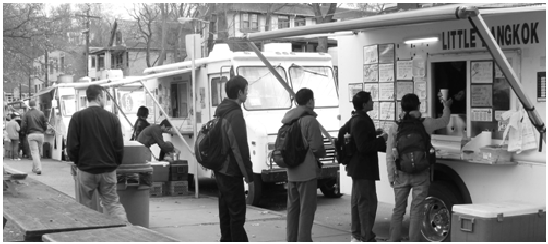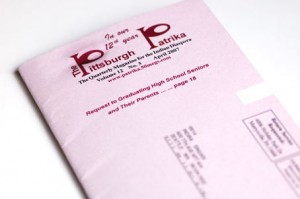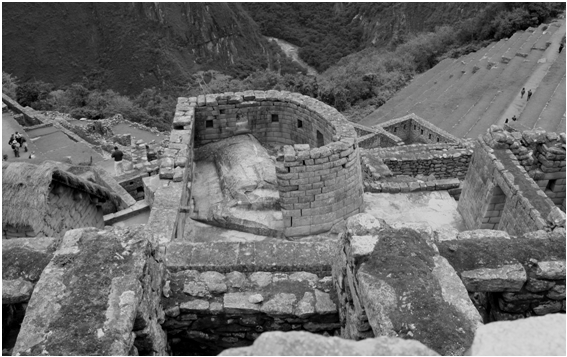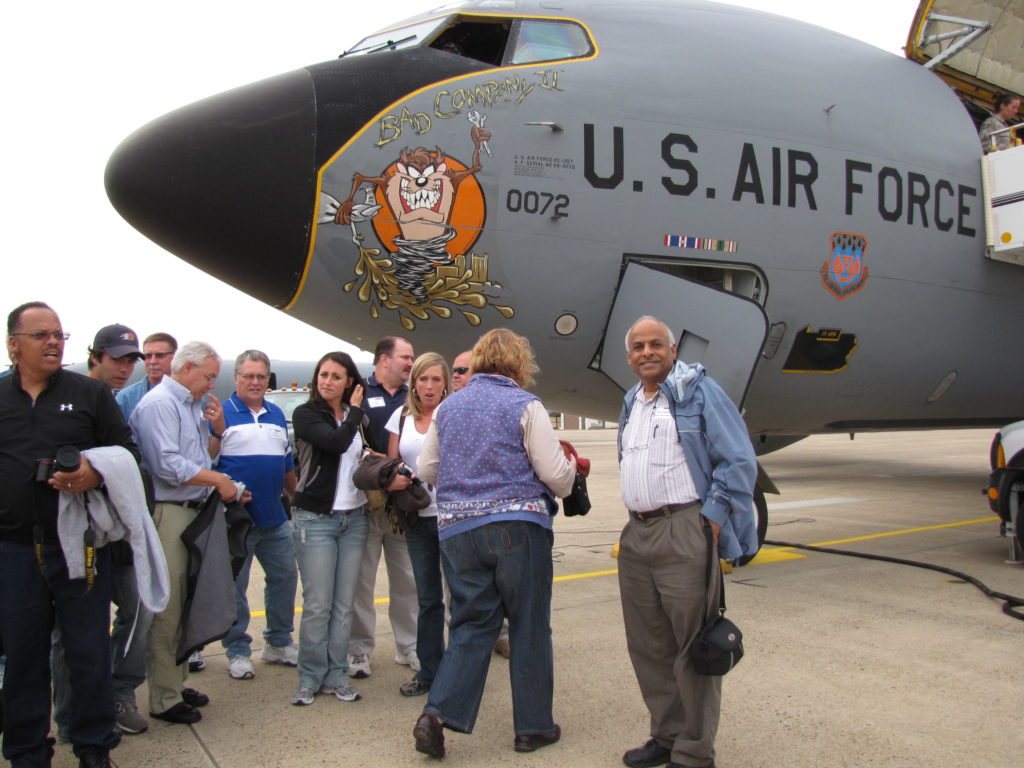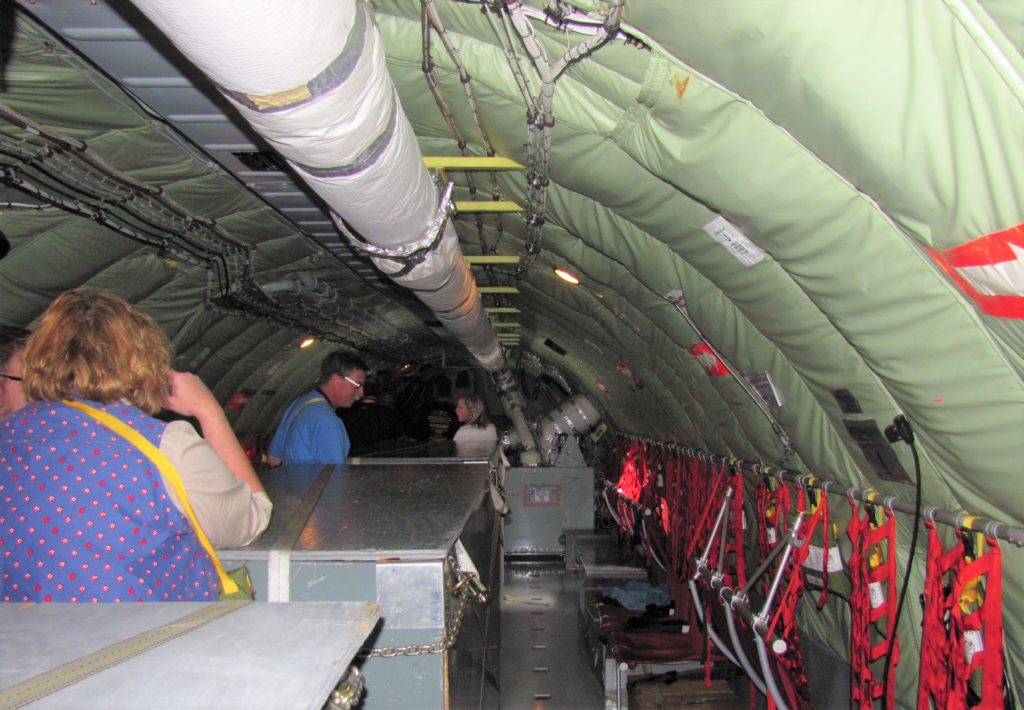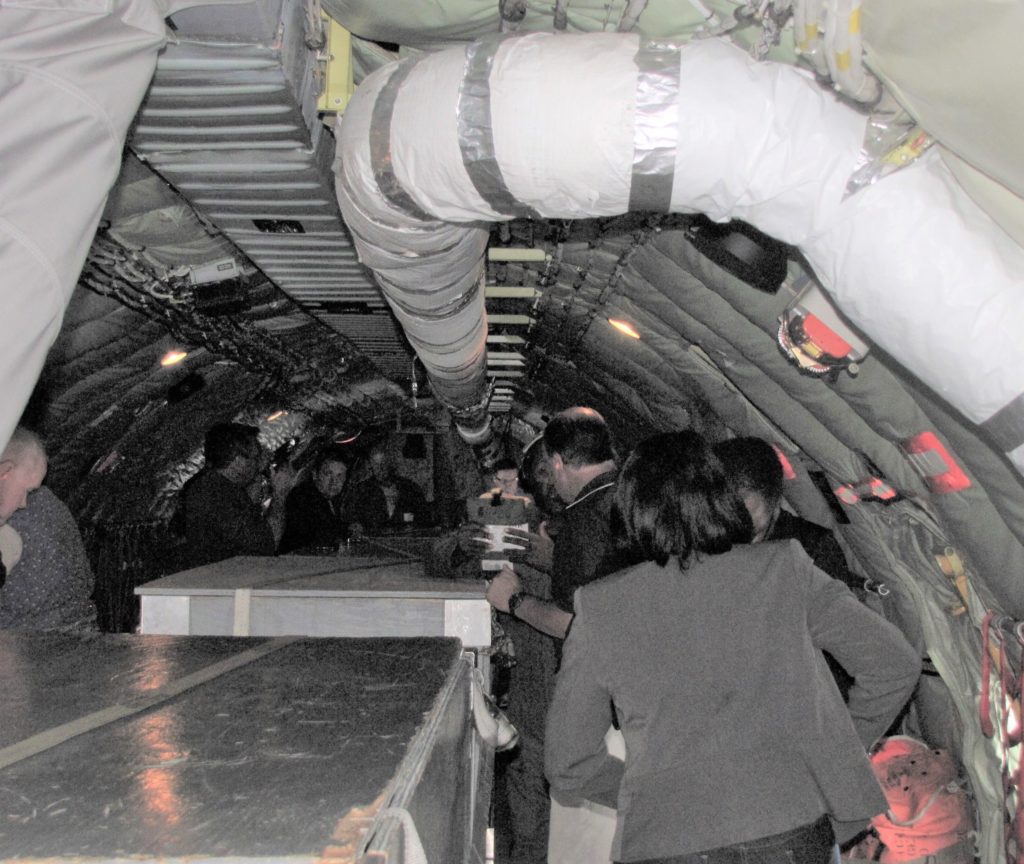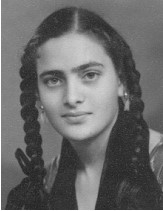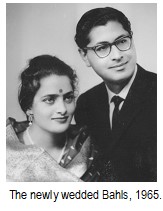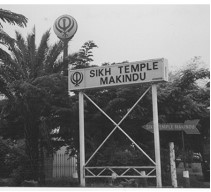Delightful Street Foods of Bombay
Posted by admin in January 2010 on March 4, 2010
By Premlata Venkataraman
E-mail Premlata
Recently I read in the NYT that they have instituted awards for the superb street food collection that exists in New York. That brought memories of my Bombay days… … …
I was lucky I lived in Bombay which is a gastronomes’ delight for food from all regions of India. I am not talking of the trendy restaurants that litter all over the city today. I am referring to the street food culture in Bombay where you can get every meal from breakfast to late night snacks (even after watching the late-night “2nd show” crappy masala Hindi movie!)
And what an array there was… … You could have piping hot dosas with chutney & sambar, or with an egg fried on top. You could have the uniquely Bombay pav bhaji, the delicious and nutritious lunch of the rich and poor alike, served piping hot and spicy and, also hygienic because no germ would survive those volcanic temperatures.
You could have the real poor man’s snack vada pav at any time of the day and wash it down with a glass of water and call it a day. Of course the bhel puri/sev puri/dahi puri combos were ambrosia from heaven to stifle hunger pangs at any time of the day.
And pani puri, the snack that is a symbol of democracy and equality in eating.. Customers stand in a circle around the vendor as he plunges his thumb into the small 2″dia hollow puris to make a hole, fills the puris with spicy potato pieces, dunks the puri into sweet-and-tart jeera-tamarind water, and hands it over to his customers one by one. You put it into your mouth, and a rainbow of culinary experience explores in your mouth: As you bite into it, you find it is crispy, salty, cool, spicy hot, tart, sweet, with just enough liquid to smoothly swallow it down transporting you into a rapture of sorts to your taste buds… …
The New York Times story mentioned that Biryani Cart, won the People’s Taste Award at the Vendys second year in a row. They also commented that, “Their rice is a lot better than any of the other street carts. Most have plain old yellow rice. Theirs is actual biryani.”
Of course, in New York with its diverse multinational population, it is easy to have street food running the gamut from Japanese to Icelandic to Brazilian. (some more infor about the Vendys…)
Even after living in the suburbs for over 20 years, I have not lost my penchant for eating street food. Luckily I work in Oakland in a university, where we have several ethnic food “enclaves” – really they are street foods served from a truck — that serve the same delicious, hot, inexpensive fare for those days I do not pack a lunch. See above: Dining a la “Carts” at CMU. Inset: Saran from Thai Kitchen graciously serves food.
On the Outcome of Interfaith Gatherings
Posted by admin in January 2010 on March 4, 2010
By Kollengode S. Venkataraman
Interfaith dialog has been with us in this area for well over thirty years. A few Hindus and Sikhs, on their own personal initiatives, and decades before temples jumped into the bandwagon, met with mainstream Christian and Jewish groups during the year-end holiday season. After Nine-Eleven, interfaith dialog gained urgency, and officials from temples, gurudwaras and mosques all over the US have become proactive in organizing interfaith meetings in their places of worship.
In India, given its convulsive history in matters of religions and faith, live-and-let-live is the norm more-or-less, with no formal attempts for any faith-related dialog. This works for the most part until fresh inter- and intra-religious violence erupts, after which society adjusts itself to a new pseudo equilibrium. This cycle repeats itself over and over again.
Living in the U.S., I always wondered what the tangible outcome of these interfaith meetings is, given all the efforts that have gone into organizing these events, other than giving the representatives of the different faiths  face time to recognize that the fabric in America’s social-cultural-religious quilt is changing.
Representatives of the diverse faiths participating in interfaith meetings differ substantially on the matters of both body and spirit of the important underpinnings in their respective faiths. But when they share the stage and talk to each other on the effectiveness of the interfaith dialog, and address the general public, despite their theological differences, they will agree on their pessimistic and less than sanguine assessment of these meetings. But they can’t say it in public.
In this background, I read an article by Dr. Farish A. Noor, a Malaysian and a Senior Fellow at the S Rajaratnam School of International Studies, Nanyang Technological University, Singapore. He has spent over 15 years in interfaith dialog, and what he says is quite disheartening:
“I have been in this dialogue ‘business’ (and it is a business, mind you) for more than fifteen years now, with no tangible results, having attended more than fifty conferences, I have had the privilege of meeting the Pope, the Ayatollah of Iran, hundreds of prime ministers, presidents, ministers, deans, rectors, professors and public intellectuals; but with little to show for it. The inter-religious dialogue industry has become a law unto itself, driven by its own infernal logic and political economy that ultimately benefits only five-star hotels who… …host such events.”
He continues: “Everyone agrees that all religions preach peace and love, but as soon as they return they declare war on their neighbors. None of the sensitive, thorny issues — such as freedom of belief and conversion [coercive or enticed, we may add] is ever discussed, and all we have are platitudes and commonsensical bits of pedestrian wisdom dressed up as sound bites… [Meanwhile] age-old differences and prejudices remain intact and nobody really wants to be honest about our collective hypocrisy.”
He goes on: “[In these meetings, speakers] invariably frame inter-religious differences in terms of an oppositional dialectics where the Self [or one’s faith] is contrasted positively to the negative Other; and from these dialectical premises we are [expected] to reach a consensus and a great communal love-in. To expect such results from such flawed premises is silly to say the least, and waste of time and financial resources.”
In Pittsburgh I have attended a few interfaith gatherings myself, not as an organizer, but as a lay listener sitting in the audience. And I see Dr. Noor’s points. Several years ago I attended what was billed as an interfaith meeting at Carnegie Mellon University with a rabbi, pastor, priest, and maulvi, and two lay followers (one Hindu, and the other Zoroastrian) participating. As the meeting unfolded, it ended up with speakers scoring rhetorical points over each other’s faith. A few atheists in the audience derided everybody on the panel.
Often the formats of interfaith dialog are predisposed to failure simply because spiritual journey — the real purpose of all religions — is always arduous, painfully slow and solitary. Over 2500 years ago, it took several years for Siddhartha Gautama to become the Buddha. It is no different today. Decades ago, while in India, I remember reading about a few European Jesuit missionaries working in India for years, only to leave their order, becoming Vedantins.
This solitary spiritual journey, though mentally arduous, I must add, is rewarding in the end for individual Seekers of Truth. Siddhartha Gautama spent years before becoming the Buddha. So is the case with Vivekananda and Chinmayananda in our times, and others in every faith.
But when religions are organized with hierarchies, managing the temporal affairs of churches seriously erodes their legitimacy as we see repeatedly in all faiths, “Harvesting souls” — actually, it is increasing the market share — becomes an objective. “Harvesting souls” is how Pope Paul John II euphemistically put it during his visit in India in 2004 about hitting heard count targets in organized conversions.
Dr. Noor continues: “We talk of ‘bridge-builders’ …as if the inter-religious dialogue was already a contested territory … To even suggest that Is’am and the West require bridge-builders is to assume that there is a gulf between the two, and that this gulf has been there all along.”
But isn’t this the simple truth staring at all of us?
Again, Noor: “The fact is that both the Western and Muslim worlds share the same Abrahamic roots — and that both have been the oldest civilizational neighbors to each other. In our attempts to be politically correct and to recognize differences — we have invented divisions that were not there (or perhaps were not so pronounced in the past) and amplified them instead.. And instead of accepting that neither the Western nor Muslim worlds are homogeneous, we perpetuate the febrile fiction that the two are distinct and therefore need representation and representatives.”
Dr. Noor’s thesis that faiths that trace their tenets to a common root should not have so much strife contradicts what we see all around. The scriptures of the many faiths themselves and their dogma do not bear witness to this. Nor does the flow of world history. Read End of Faith by Sam Harris for details. Strangely, while Harris is harsh on organized religions, he himself is a seeker of personal spiritual growth.
On the basis of Dr. Noor’s thesis, how do rationalize the following?
- The strife between Jews and early Christians that persisted through two millennia leading to the Inquisition and persecutions?
- The strife between the Vatican and the Eastern traditions of Christianity, namely, Russian, Greek, Syrian traditions?
- The clash between the Catholics and the Protestants in Europe since the time of Martin Luther and the birth of the Anglican Church? Read Ross Douthat’s article “Benedict’s Gambit” in New York Times on Pope Benedict’s overture to the Anglicans to stem the rise of Islam in Europe.
- North American Evangelicals and Charismatics raiding the flock of traditional Catholics in Latin America?
- The divisions between Shias and Sunnis soon after the death of Prophet Mohammed? And Shias and Sunnis together not recognizing Ahmedias as Muslims, considering them apostates?
The scene in India is similar, but not anywhere as violent I must emphasize, as among the Abrahamic religions in Europe and the Middle East.
- So was the case with Hinayana (Theravada) and Mahayana Buddhism at the peak of their influence in India. Ironically, Buddhism, by far the most practical and nondogmatic religion, could not avoid getting enmeshed in dogma after the Buddha’s time. Incidentally, Hinayana (literally, smaller or weaker vehicle) is a pejorative phrase coined by Mahayanis. Theravada (or the Path of the Elders) is how Hinayana is now called.
- Among Jains, Digambars and Shvetambars have had strong differences, though not violent, thanks to the Jains’ commitment to ahimsa.
- Hindus have had their differences with the Buddhists and Jains, some of whose outcomes were not very pleasant, to say the least.
- Among Hindus, the Advaitins, Saivites, and Vaishnavites differ on theology, dogma and rituals, which has manifested in silly, laughable ways. The caste differences among them add another layer to the complexity.
- And Vaishavites among themselves have problems too. In India, the two branches of Tamil Vaishnavites — Vada-kalai and Then-kalai, literally Northern and Southern Schools — went all the way up to the Indian Supreme Court. Why? To resolve whose naamam (the religious mark in vermillion and white clay powder traditional Vaishnavites wear on their forehead) can be put on the forehead of the elephant in the Vaishnavite temple in Kanchipuram. (Note for the uninitiated: The naamam of the two sects differ slightly that outsiders may not be able to notice at all.)
Coming in this tradition of theological nitpicking, Indian communists with their allegiance to Russia have had problems over doctrine with Indian Marxists whose inspiration in China, similar to religious orthodoxies. Recently, Indian Marxists vowed to annihilate Maoist in Central India.
Human institutions are like living organisms. They grow, bifurcate or trifurcate, become weak, die and become extinct, or morph and evolve. And man’s instinct to influence, control and dominate others, and others’ instinct to resist, are visceral that bring out the animals in human beings. However, highlighting the differences in the arcane nitpickings in dogma and theology give man a patina of intellectual sophistication for his instinct to control and dominate. Of course, when intellectual persuasion fails, inducements and brute force are always there.
I think the driving force for much of the religious strife is as much biological as it is theological; driven as much, if not more, by man’s hormones as by his intellect. I use masculine pronouns deliberately. Without sounding sexist, why is that through history, the leaderships in religious and political strife have been overwhelmingly male? ♠
Traveling in the Sacred Valley of the Incas
Posted by admin in January 2010, Travel on February 23, 2010
By Padma and Raman Venkataramanan,
Pittsburgh, PA
E-mail Padma
In a previous issue we had discussed our trip to Peru. After visiting Lima the capital of Peru we went to Cusco, the original capital of the Incan empire and the gateway to many Inca ruins. After enjoying the city of Cusco and the nearby ruins, we visited a few small towns near Cusco before our trip to Machu Picchu.
Sacred valley of the Incas: The “Sacred valley of the Incas” (The Urubamba valley), has beautiful stretches of small villages (Pisac, Urubamba, Ollantaytambo and Chinchero, to name a few), and ancient ruins spread across the mountain slopes. The Urubamba river had made this valley a fertile agricultural center for the Incas, who grew white corn, coca, potatoes, peaches and avocados. The agricultural sector extended well into the spectacular terraced mountain slopes. In Pisac, we saw a large fortress complex built by Incas high up on a cliff . See the picture below. Here you also see one of the largest burial sites of the Incas. The artisan and antique market in the central square in Pisac is famous for sweaters, ponchos, tapestries, rugs, musical instruments, and carved gourds.
Ollantaytambo is a beautiful village with streets dating from the Incan times. The streets are lined with brick walls and in the middle one can see the canals carrying water from the mountains. One can also see terraced ruins of a massive temple fortress built by the Incas and the agricultural terraces. On the mountain side there are granaries built by the Incas and the carved faces of the Incas can be seen on the cliff. In Ollantaytambo, we were fortunate to see a residential canchas or blocks built and inhabited in the 15th century. Each block contained a set of three houses that open into a court yard and in the center was the common storage area. Each of the houses essentially consisted of a huge room with a prayer table set at one end (the skulls from the ancestors were kept here to protect the inhabitants); the beds lining up the wall on the other end; and the kitchen area in one corner. Guinea pigs were running around in one side (but they seem to know their limit), and the local Peruvian ladies were busy with their handicraft work on the other side. See the picture below. There is also a second level storage area inside this room right above the beds. It was interesting to see how efficiently they had used the small room for so many activities for the entire family. Leaving Ollantaytambo, we get a gorgeous view of the snow capped mountain ranges of Urumba, Salcantay, and Vilcabamba, near the town of Chinchero.
Machu Picchu (the lost city of Incas): Now it was time to visit Machu Picchu. Machu Picchu is the lost city of Incas. The Incas built it so high up in the mountain that it escaped destruction by the Spaniards who occupied Peru. Machu Picchu was rediscovered in 1911 by the Yale archeologist and historian, Hiram Bingham. Hiram, who was actually looking for Villacabamba, the last refuge of the Inca, Monga and his army, came to know about the ruins in Machu Pichu from a local farmer, Melchor Arteaga. Melchor and two local Indians Richarte and Alvarez directed him to the ruins in Machu Pichu. It was Hiram and his companion Sergeant Carrasco who first set eyes on these extraordinary ruins in July 1911.
One can hike for four days, about 33 kilometers, on a rugged path to Machu Picchu from near the village of Ollantaytambo, or take a train from Cusco to the town of Aguas Calientes, at the base of Machu Pichu. We took the vista dome train from Cusco early one morning and reached Aguas Calientes around 10 am. The scenery on the way was just impressive. Aguas Calientes is a small tourist trade town, known for its thermal baths. After lunch and some rest at the Inca Inn, we walked along the Urumba river and visited a museum on Machu Picchu (a good place to get some orientation to the place), and then a botanical garden (to see the local plants and shrubs). We walked through the local shops, checking out the colorful local goods. See below.
The next morning we took a bus to Machu Picchu. Machu Picchu means “old peak.” The city of Machu Picchu sits atop a mountain well above the Urumba river, and is surrounded by breath-takingly beautiful peaks, all covered with the mist from the Urubamba river down below. It was like magic; it was a spectacular archeological site.Hayana Picchu (young peak) sets up a dramatic backdrop to Machu Picchu. We decided to climb up Huayana Picchu. We hadn’t planned on it, but couldn’t resist the once-in-a-life-time opportunity. The climb was quite steep at some places. As we climbed this mountain, the cloud cover slowly lifted up and as we reached near the top, we could see the stunning piece of Incan architecture down below. (See the picture on the front cover). The ruins of Machu Picchu were nestled in the mountain top surrounded by several mountains and the Urubamba river in the valley in between. It was just spectacular. It is a place of mystery and magic. Nobody knows exactly what it was built for – was it a citadel, an agricultural site or an astronomical observatory? A ceremonial city or a scared retreat for the Incas? Or a combination of all these? No matter what it was originally meant for, it is just awesome. No photograph can do justice to the beauty of this place. You have got to be there to enjoy/feel it. We were glad we claimed Huayana Picchu and take in this spectacular view.
We then walked down to the city of Machu Picchu. By now the place was filled with tourists; we were glad that we got there early in the morning to enjoy the place from Huayana Picchu in peace and quiet. The city landscape was broadly divided into lower and upper industrial section and lower and upper agricultural section. We first walked into the agricultural sector; then went past the dry moat into the city itself. Then walked right into the fountains (small waterfalls, actually), then went through the Temple of the Sun; Temple of the Moon; Temple of three windows; Temple of the Condor; the Quarry; and the Royal tomb. Steep terraces, gardens and lime stone temples and aqua ducts that have all been carved out of the hill side. One cannot escape asking the question ‘How did they do it? How did they find such a place to build this?” It was a treat. No where have we seen such a combination of natural beauty and the pioneering spirit of human being merge in one place as it does here in Machu Pichu. After taking it all in, we took the bus down to Aguas Calends, and then the train back to Cusco. Got to Cusco around 7 pm, fully contented and thankful for this unique and wonderful opportunity.
No wonder UNESCO has classified Machu Picchu as a heritage site. It is the eighth wonder of the world.
Suggestions if you plant to visit:
Flight: Fly from Pittsburgh to Atlanta or Ft. Lauderdale to Lima to Cusco to Machu Picchu. Duration of trip: Plan for a week’s trip.
Need three days in Cusco – get acclimatized to the altitude and do local sites (Cusco, the sacred valley of the Incas)
Need two days in Aqua Calientis and Machu Picchu – spend a whole day in Machu Picchu; start early in the morning from Aqua Calientis.
Need two days in Lima – local sites
Food: Vegetarians, pack some food with you.
Time to go: May through October
Temples Need to Attract Our Own Gen-X
Posted by admin in January 2010 on February 23, 2010
by Lakshmanan Krishnamurti,
Pittsburgh, PA
Email Lakshmanan
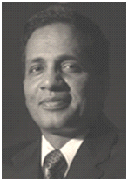 Lakshmanan Krishnamurti was born in the temple town of Madurai, India. He has lived in many places in India, first as the son of an Indian Air Force officer and then as a physician in the Indian Air Force. He moved to the US in 1993. He is currently a physician specializing in blood diseases, cancer and bone marrow transplantation in children.
Lakshmanan Krishnamurti was born in the temple town of Madurai, India. He has lived in many places in India, first as the son of an Indian Air Force officer and then as a physician in the Indian Air Force. He moved to the US in 1993. He is currently a physician specializing in blood diseases, cancer and bone marrow transplantation in children.
The article by Sridevi Rao James in the last issue raises important questions on how to sustain Hindu institutions in the United States. Rao James observes that as the first generation of founding Hindus slowly fades away, the mantle of leadership will have to pass to the next generation born and raised in the US. At first glance, this appears to be an obvious an inevitable change. However, public institutions are living organisms with a natural life cycle of growth, maturation, stagnation, even decay. They can also change course according to the people who participate and run these institutions. The composition of the worshippers and leadership of religious institutions set up by immigrant communities in the US will change over time. Many may even cease to function as the founding members of their congregation age and eventually fade away.
Ms. Rao James says, depending on only new Indian immigrants to take care of the temples is not only shortsighted but also likely to further alienate the already disengaged Hindu Indian-Americans born and raised here. The alienation of US born Indian-Americans from Indian immigrant students and their institutions is evident on university campuses. However, there is a distinction between college students who may be still grappling with their own identity and their need to fit in and adults who are trying to raise children in their own cultural traditions.
In Hindu temples across America, Indian immigrants, US-born Indian children and adults, American spouses, interracial children and some children and adults with no Indian heritage at all, all worship and participate in the various classes and activities, motivated by their interest in the Hindu tradition. That these individuals with diverse backgrounds are able to participate in the activities of the temple indicates that these institutions not only welcome people from different backgrounds, but also accept the attitudes and values people from diverse backgrounds.
If US-born Hindus overcome their reservations and become involved in these institutions, they will fit in very well..
There are however, many challenges that we face to make our institutions relevant and attractive to our young people. Attendance of children in Temples drops off after 10th grade though some young college students continue to attend. Hindu temples in the US are thriving largely because of the dedication of the large number of recent immigrants and the organic link they provide to India. However, the seemingly unending supply of immigrants from India is subject to change by social, political and economic forces.
While many Indian immigrants view their institutions through the prism of caste, region, language, and social mores as they existed at the time of their emigration from India, others are completely turned off by these.
For too many immigrants, the temple is merely a salve against social isolation and a means to get the acceptance they seek, but do not seem to get elsewhere.
As the new immigrants have struggled to adapt to the American mainstream, a whole generation of American-born Hindus have come of age. They take for granted the fruits of the struggles of their parents. Besides, youngsters, often pushed by their families to excel in school and at work, have had neither the time nor the opportunity to acquire more than a superficial familiarity with their culture and religion.
Many living in biracial and two-religion households may find the institutions of the non-Hindu/Indian half of their families more welcoming.
US-born Hindus may be different from their Indian born parents, but that does not make them less deserving of celebrating their religion, culture, and heritage. We ignore this shift in the demographics at the peril of losing the long-term viability of our institutions.
How do we attract and retain the interest of this generation? The
answer is astonishingly simple. We, who are rediscovering Hinduism in America, need to restore temples from their recent role as mere places of worship, to their traditional place as centers of social and cultural life of our communities. This holds the possibility that American-born Hindus will be drawn to these places during the different transitions in their lives. We must also actively recruit US born Hindus of every age to our temples, trust them, and give them responsibility of running it.
Like Rao James, I too believe it is time to be creative and thoughtful about how to bring our youth back into the fold. Otherwise, Hindu temples all across the US built with love by a whole generation of immigrants may survive only as museums.
Editor’s Note: We thank all the authors who came forward to share their thoughts and ideas on this thread of topic. This topic, we hear, has triggered lot of table-topic discussions in many homes and gatherings of our readers.
Fareed Zakaria at Carnegie Hall
Posted by admin in January 2010 on February 23, 2010
By Nita Wadhwani,
Pittsburgh, PA
Email Nita
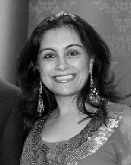 Fareed Zakaria, in his keynote address delivered at the Carnegie Hall last fall, said, “It is now a new Middle East,” and “The Persian Gulf states represent the future of the Middle East more so than countries like Egypt and Syria.”
Fareed Zakaria, in his keynote address delivered at the Carnegie Hall last fall, said, “It is now a new Middle East,” and “The Persian Gulf states represent the future of the Middle East more so than countries like Egypt and Syria.”
He was in Pittsburgh last October at the invitation of the Pittsburgh Middle East Institute (P.M.E.I) to talk on “The Real Solution to the Middle East Crisis” His speech at the Carnegie Music Hall on October 13, 2009.
Fareed Zakaria hosts CNN’s international affairs program Fareed Zakaria GPS on Sundays that is telecast worldwide. He writes a weekly column for Newsweek and has written several books including The Future of Freedom, a New York Times best seller. His most recent book, The Post American World, is an instant best seller. Born and raised in India, Zakaria, now 45, was the managing editor of Foreign Affairs when he was barely 28.
Introduced by Paul O’Neal, the Secretary of Treasury for George W. Bush, Zakaria delivered an engaging insightful speech sprinkling it with humor. He started the evening with his assessment on the current economic situation: “We are not living in a workers’ paradise” and “the world will never be the same again.”
Zakaria felt that since 1979 there are fewer political conflicts in the world. He said places in the Middle East have linked modernity to education, citing Dubai as an example:

L to R: Sayyid Badr Al Busaidi, Lyutha Al Mughairy, officials from the Sultanate of Oman, Fareed Zakaria, Hunainah Al Mughairy, Oman’s ambassador to the US, and Simin Yazdgerdi Curtis, Founder-Presi-dent of P.M.E.I. in the meeting.
“There is plenty of money in the Middle East, and rulers there are trying to link it to education,” persuading internationally recognized education institutions “such as Carnegie Mellon Institute and other schools to open their branches in the area.”
The Middle East has prospered with diversity, he said. “The money coming from Persian Gulf is changing the world. The power of capitalism has transformed the area. … … The Persian Gulf states represent the future of the Middle East more so than countries like Egypt and Syria,” said Zakaria.
He touched on sensitive topics like Iran and Pakistan with reference to US foreign policy priorities and objectives. The biggest strategic challenge for the US would be its relationship with China, he said. He was optimistic that it would be managed well by their leaders.
This is understandable. After all, we in the US can sustain our lifestyle only with cheaper imports from China. This has led to huge trade deficit with China. And China is also financing our debt. But China’s global economic, political and military ambitions do not align with the foreign policy objectives of the US.
Discussing Pakistan’s role as a challenge for peace in the Persian Gulf area, Zakaria said, the Persian Gulf’s regimes are aware that many attacks in their area have originated from Pakistan. The regimes there are dealing with the rise of the Islamic fundamentalism in the region.
The evening ended with some questions and answers. Zakaria was candid and humorous in his responses:
Q: How would you rate Secretary Clinton’s first year as Secretary of State?
A: When the president himself is engaged in foreign affairs, it limits the role of the Secretary of State.
Q: Can Iran negotiate in good faith?
A: Yes even though it is a rigid theocracy. But it will not negotiate its nuclear policy. It is surrounded by neighbors with nuclear weapons.
The evening ended with Zakaria receiving a Steelers jersey.
The evening was organized under the aegis of the Pittsburgh Middle East Institute (P.M.E.I), an independent, nonprofit organization dedicated to promoting educational and cultural partnerships between Pittsburgh and the countries of the Middle East. This was their 2nd annual meeting.
Pittsburgh Needs a Regional Solution
Posted by admin in January 2010 on February 23, 2010
By Kollengode S. Venkataraman
 Recently, Pittsburgh Mayor Luke Ravenstahl’s proposal for a 1% tax on college tuition drew a lot of flak. Obviously, nobody likes taxes. As with many fiscal problems the nation is mired in, the fiscal problems of Pittsburgh have been growing for over two decades since the decline of the steel in the 1970s. All elected officials were only too aware of them.
Recently, Pittsburgh Mayor Luke Ravenstahl’s proposal for a 1% tax on college tuition drew a lot of flak. Obviously, nobody likes taxes. As with many fiscal problems the nation is mired in, the fiscal problems of Pittsburgh have been growing for over two decades since the decline of the steel in the 1970s. All elected officials were only too aware of them.
In many parts of the nation, during the years when oil was aplenty and inexpensive, the suburbs grew at the expense of the cities. There were also strong underlying social trends contributing to this: School busing, high crime rates in inner cities, and housing integration all contributed to what sociologists called the White Flight in which suburbs grew at the expense of cities. The graph below encapsulates this trend in our region.
The data for this plot were taken from http://www.spcregion.org,the website for the Southwestern Pennsylvania Commission, the forum for collaboration and public decision making. This forum comprising of elected officials from the ten counties around Allegheny County also has state and federal government officials. The other source for the data is of course the US Census Bureau. The following numbers are worth extracting from the plot.
We see that Pittsburgh’s population has disproportionately decreased from its peak when compared with the population declines in the region.
Secondly, nonprofit organizations — educational institutions, hospitals, places of worship, museums, recreational facilities, and many, many others — occupy a large chunk of real estate in town. The tax-exempt nonprofits, as elected officials have stressed, considerably reduce the city’s tax base.
To add to the city’s woes, a large number of suburbanites- estimated to be the entire population of the city – descend onto the city or drive through the city every day for work, recreation, and transacting business. This many number of people coming to the city every day drains a lot of city’s resources. The mayor simply can not pile more tax on city’s shrinking number of residents to fill the gap.
Yes, the city’s financial problems have been festering for a long time. But the tax-exempt nonprofits are not on moral high ground when they complain about the mayor’s 1% tax proposal on tuition.
The entire healthcare industry has been raising their charges on patients every year. Colleges and universities too have been continually raising their tuition to students. And the supposedly nonprofit UPMC makes obscene profits and has a huge and arguably aggressive presence in town.
The decline of steel in the 1970s devastated the entire region, and USAirways shutting down its hub at the Pittsburgh airport financially ruined the airport. So, we can argue that UPMC’s increasingly dominant presence may not be good for the city or for the healthcare industry in the region in the long run. Besides, the nonprofits are not living on shoestring budgets. The profligate management styles of the nonprofits and the salaries of their executives make one wonder if we need to change the definition of nonprofits for tax purposes. See Sally Kalson’s article UPMC: at odds with itself (www.post-gazette.com/pg/07140/787267-149.stm).
There are other solutions to the region’s problems. One is consolidating the 120-plus municipalities in Allegheny County into a SINGLE municipality. But given local politics and the refusal of the affluent neighborhoods to shoulder the region’s problems — even though they fully exploit and benefit from the city’s resources — we can as well wait for the Second Coming.
I’ve called Luke Ravenstahl “Fluke” Ravenstahl because he became the mayor by accident when Mayor Bob O’Conner suddenly died. Obviously, this epithet is misplaced because the mayor is expected to solve Pittsburgh’s huge financial mess. If anybody has a viable, equitable alternative to bridge the $15 million hole in the city’s budget, give him a call. He is all ears.
Uncommon Adventures — Witnessing the Dangerous and Highly Skilled Job of Air Refueling
Posted by admin in Past issues, Venkat's and Others' Selected Earlier Articles on October 15, 2009
Kollengode S Venkataraman (published in October 2009)
Recently in the wake of the FBI Citizens Academy graduation I had a unique opportunity to witness and participate in a air refueling operation by the Penna Air National Guard operation.
The Pennsylvania Air National Guard’s 171 Air Refueling Wing operate from their base close to the Pittsburgh airport using the airport’s infrastructure — runways and air traffic control — to reduce their costs for their operating their flights. I was one of the over dozen participants in this exercise.
Air refueling is a 100% military-related operation but the Guardsmen, who are under the command of the governor in most states, also respond to natural disasters for supply and rescue mission, as they did during Katrina.
On the stated date (July 22, a Wednesday), we assembled at the Air National Guard facility adjacent to the airport. I was under the impression that they would show us a video, or make us sit in a simulator — maybe take us for a short ride, over Lake Erie and bring us back.
But was I in for a huge surprise!
As we sat through the briefing by Brig. Gen. Rou Uptegraf, Commander of the Pennsylvania 171 Air Refueling Wing of the Pennsylvania Air National Guard, it became crystal clear that this was THE Real Deal!
The flight crew (two part-time volunteer pilots Eric Yockey and Keith Stephen and two full-time “Boom†operators John Cima and his colleague) informed us that we would fly due east all the way to the Atlantic shoreline in the NY/NY area and fly well into the ocean. We would be air-borne for nearly 4 hours! There, our “mother†plane would dock with another plane requiring refueling during flight.
We had been asked to come prepared for cold temperatures inside the plane and were also cautioned that the plane’s toilet facilities are minimal.
The utilitarian 50-year old plane was C-135, the military version of the old Boeing 707. We drove past several of these planes, something that you can see if you land on the run way closest to their parking yard. We entered the grey painted plane through the very large door on the side. Even though thee planes are very old, we are told, their dedicated crew take great pride in keeping the plane fully operational ALL the time.
The barebones interior was with wires and cables and HVAC ducts exposed and running the entire length of the plane. The highly visible insulation/noise muffling layer was kept in place with the liberal usage of what appeared to be duct tape. The plane had only 4 windows – two on either side – along the entire length of the fuselage. The cockpit was open to those who were riding in the plane.
The seats arranged along the length of the fuselage were barely functional, made with woven 2†or 3†wide bright red tapes like what we see in garden chairs. In the middle of the fuselage along the length of the plane were five sets of multipurpose cargo boxes for transporting anything that would fit into the box.
As the plane taxied to the runway, even before we were airborne, it was clear this would be a very, very noisy ride.
Once we were cruising at 26,000 feet we walked around the cabin. All of us took turn and entered the cockpit during the flight and sat right behind the two pilots. To have the pilot’s view (nearly 270 degree views) of what was outside the plane was a treat of a lifetime for all of us. The veteran pilots were joking around with us even as they were fully focused on their job, making small talks with me on radio/intercom.
Exciting as the cockpit view of the outside was, the real action was all at the tail end of the aircraft! For this is where the maneuvering for the refueling takes place. Conceptually, a hose from the “mother plane†has to dock into the fuel receptacle on the fuel-receiving plane. The only constraint is that this has to be done at 20,000 to 30,000 ft in the air while the two planes are flying at nearly 500 mph. And everything has to be done by remote control.
This is where the “boom†operators come in. These highly skilled technicians’ agility, skills and concentration at their task and their professionalism are very inspiring. They train, we are told, hundreds of hours on simulators, perfecting their technique before getting trained under a veteran boom operator in actual flight.
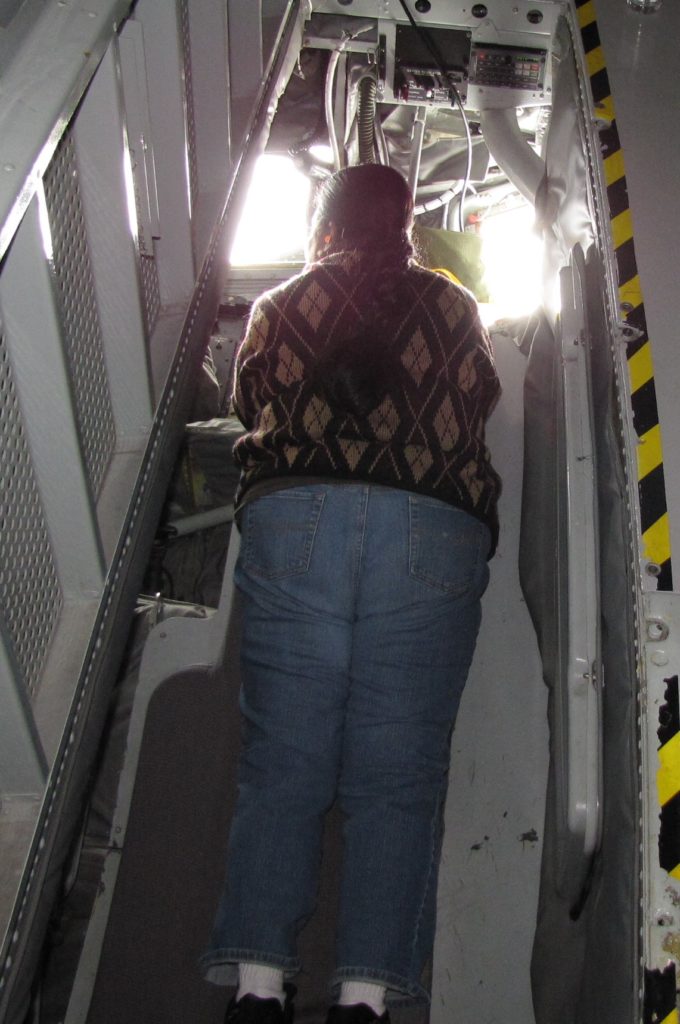
The whole operation takes highly coordinated communication among the pilots in both the planes and the boom operators as they maneuver the two planes close enough – but not too close — to dock the fuel hose from the mother plane to the receptacle on the top of the front end of the receiving plane, just above its cockpit.
The boom operator working with very limited space operates several joysticks and control knobs to move the “boom,†— which has the hose installed in it. He lies flat on his stomach on a padded mat like a Yoga mat and operates the joysticks and other knobs while looking through the three windows, the largest of which measured maybe 24†x 12â€. By working on the joystick, the boom operator moves the hose independent of the mother plane, and with great skill, docks the discharging end of the hose on the receptacle on the top of the receiving g plane. When the hose coupling comes very close to the receptacle of the receiving plane, a powerful electromagnet attracts the hose plumbing fixture and locks it into position on the receptacle in the receiving plane.
I was looking through the window lying on my stomach on the mat adjacent to the boom operator as we were flying at 26,000 ft at ~ 500 mph (ground speed). At a far-away distance, I saw a plane approaching us. The boom operator told us, that is the plane we were about to re-fuel in flight.

As the plane got closer to us, I could see the military jet plane’s four-engines… … then I saw the inscription US AIR FORCE painted on the side of the fuselage. And then I could see the number on the plane 3084.
As the plane needing the fuel got closer still, I could even see the pilots in its cockpit. When the plane got closer at ~ 200 feet, I could see the fuel hose receptacle, even the rivets on the fuselage and the scratch marks when the hose made contacts with the plane near the receptacle. It was an eerie experience seeing a plane in flight this close.
All the while, the Boom Operator was constantly in radio/intercom communication with the pilots in both the planes even as he was maneuvering his joysticks to bring the hose’s end of his plane to the receptacle on the receiving plane. When they come close enough, powerful electro magnets on the planes quickly brought the two ends into contact and instantaneously locked the hose into its receptacle making it ready for refueling. The Boom operator then worked his buttons to open and close the necessary valves and the jet fuel from his mother ship’s underbelly was transferred to the other plane. The unloading took may be 20 minutes transferring several thousand gallons of the fuel.
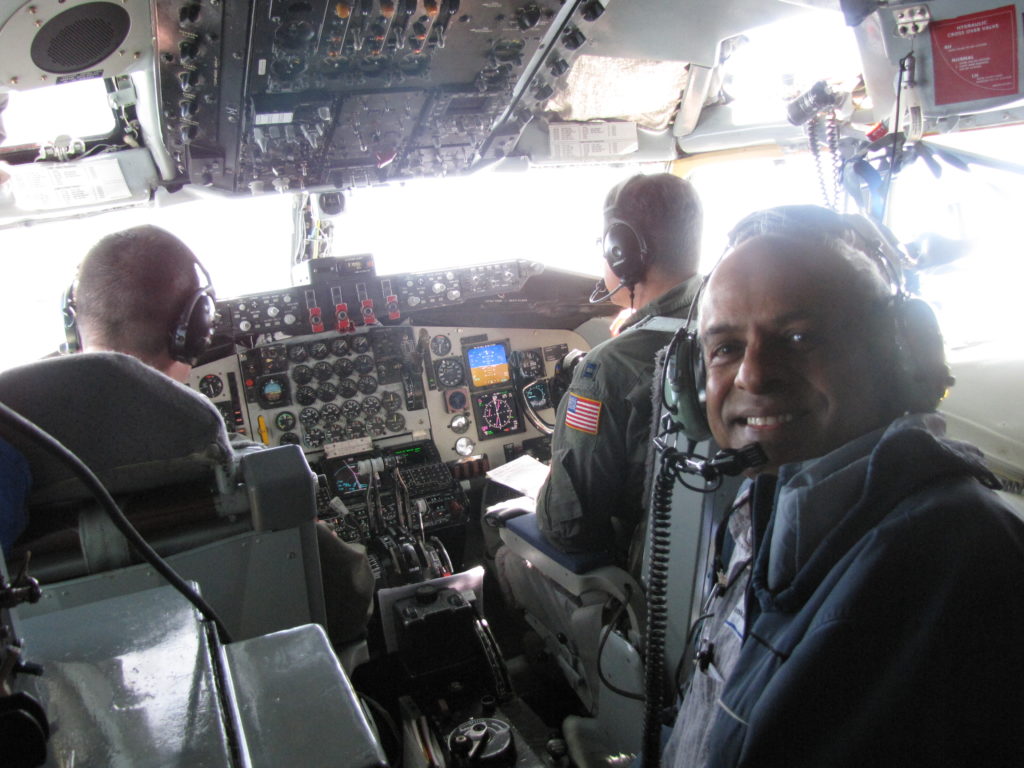
Finally, his job completed, the boom operator instructed the pilots in both ships, he is going to decouple the hose. He detached their umbilical chord, and I could see the other plane slowly receding from my plane both in distance and elevation. After some time, the plane outside veered away from ours.
Having completed our training mission, the pilot returned his plane and brought us back to Pittsburgh.
It was an unforgettable experience. I was so impressed with all the pilots, boom operators and other staff working with their absolute dedication and professionalism and pride in their skills and abilities in keeping the country safe in times of war, terrorist threats and natural disasters.
We owe them a huge debt of gratitude though we may never need their services. — END
Pittsburgh’s Palate Partners Suggests Wine Pairings for Indian Cuisine
Posted by admin in October 2009 on October 15, 2009
By Premlata Venkataraman
The flowery overblown descriptions of wines amuse me; I guess I just am not the type to go overboard over a glass of wine. While living in the Bay Area decades ago it was chic to go to wine-and-cheese tastings. Also at their peak of popularity were fondue parties — but that is another story for another day.
Recently Palate Partners, a specialty wine retailer at the Strip run by Deb Mortillaro and Mike Gonze, held an open house to demystify all the verbiage — body, bouquet, aroma, vintage— in the wine vocabulary. Their simple message: learn to enjoy wines by experimenting with different types. They do this through their affordable ($12/person) wine appreciation classes with six wines to explore.
The teaser in their e-mail was: Do you know which wine to serve with special foods? This has been a sore point with me, as I am sure it is with most readers. How do you pick wines to go with spicy Indian dishes? Even though wine is not routinely served during Indian dinners, we would still like to know which wines go with our spicy dishes for those rare events. Seeking some enlightenment on this, I went.
To my pleasant surprise, Mike and Deb, our wine gurus, were practical, friendly and helpful. Emphasizing that there is nothing objective in matching food with wines, they offered a few broad general ideas:
- Opposites attract. Spicy food needs fruity wines.
- Textures should match. Light foods with light wines and heavy foods with heavier wines.
- Popular wines don’t always match with spicy food.
- Try a new wine even if it isn’t the most popular du jour. It’s fun to try new wines and see what you like.
(Satyameva Jayate, na Asatyam)
Posted by admin in October 2009 on October 13, 2009
Anu Chandrasekhar grew up in Srirangam and earned her M.Sc degree in Chemistry. She came to the USA in 1987 after living for five years in Switzerland and Germany. She lives in Penn Hills and recently earned her MBA from the University of Pittsburgh.Â
Â
(Satyameva Jayate, na Asatyam)
It was the 15th of August, one of the proudest and most poignant days in India’s history, the day of the country’s independence. I was a freshman in high school. The principal was addressing us explaining how lucky we were to be in a free country and detailing the struggles the freedom fighters had undergone to liberate India from the British Rule. I could not control the tears of joy rolling down my cheeks when the Indian national flag was hoisted and we sang the national anthem.Then the mayor of the city delivered a speech that was very lucid, eloquent and simple to understand. He narrated the story of Harishchandra – a great King in Indian legends who was revered for his unflinching adherence to truth. The Gods tested him, cruelly at times, driving him to adversity and exile, even bribing him to tell a lie so that he could regain his kingdom. However, all the sufferings he had to endure, losing his wife and only son, did not change his stand on truth. Satisfied, the Gods restored him to his former glory and gave him back his wife and son.
Though I was impressed by the teaching, in many instances I got into much difficulty when I told the truth. When I was in middle school, I was selected to participate in a school play. My mother did not want me to stay after school for anything other than school work. I did not like to drop out of the play; so to keep my mother happy I told her I had to stay after school for school work. It never even occurred to me that I was lying. But when my mom came to know the truth from a friend of mine who was proud of my getting the leading role in the play, she screamed at me for lying to her and asked me to promise never to tell a lie.
By Anu Chandrasekhar, Penn Hills, PA
Voice of the Next Generation: A Response to Deepak Kotwal’s Article
Posted by admin in October 2009 on October 13, 2009
By Sridevi Rao James, McDonald, PA
Email Sridevi about this article.
Now our vacations involve beaches and amusement parks.
When I was young I spent my weekends at the temple at Bharathanatyam dance class, youth groups and programs that involved singing, dancing or acting. Now my weekends are spent at kids’ birthday parties, softball games and watching the Steelers. I have performed pujas with my parents and still observe Indian holy days. I can recite the Satayanarayan Katha verbatim and tell you the meaning of “eating the prasad” but don’t ask me the recipe for the prasad. I’m not sure that is enough to keep the flame going for years to come.
What I’m trying to say is, I’m not sure my generation will know what to do with that baton if it is passed to us. This is sad but true. Hopefully it doesn’t mean the end of temples or Indian cultures.
We need to find a way to bridge that gap between generations. Mr. Kotwal’s article has given everyone, both the current managers of the temples and youngsters like me, something very worthwhile to think about.
Many Happy Returns of the Day, India!
Posted by admin in October 2009 on October 13, 2009
By Meenakshi Kapoor, Greentree, PA Â
Meenakshi Kapoor was born and raised in Saharanpur, UP. After working in Saharanpur and New Delhi, she reached these shores in 2000, reaching Pittsburgh in 2002. After working for several IT companies, now she has her own staffing and consulting business in Pittsburgh. Her hobbies are reading, cooking and listening to light and classical music.
They say, you can take us out from India but you cannot take out India from us. The proof for this, if one needs a proof at all, was India’s Independence Day celebration gala — some say, it is a mela — in Pittsburgh. August 15th is a very important day in the lives of Indians in almost all parts of the world. The Indian American community, spread across the United States takes pride in celebrating India Day every year, as we too do here under the aegis of the Indian Nationality Room, University of Pittsburgh.
This popular event attracted a large number of Indian-Americans with several hundred people gathering to witness and participate in showcasing the India’s rich and diversity. The atmosphere was charged with festivity and vibrancy of Indian polyglot culture with many people waving the tricolor, participating in the parade that started from Bigelow Boulevard and went across the Cathedral of Learning.
Kirti Gulati sang “Vande Mataram†in her melodious voice, followed by “Jai Ho.â€Â People passing by were fascinated by the Garba and Bhangra dances performed on the road during the procession by the young men and women draped in bright, colorful dresses.
Inside the Cathedral of Learning, flags of US and India were hoisted, followed by the national anthems of both countries respectively sung en masse. The ceremony saw Indian American youths dancing to peppy Punjabi and Bollywood music and classical and folk dances.
Various organizations, groups & dance academies – all based in Pittsburgh Metro area — presented dances of India performed by our youth in vibrant costumes. Some of the entrepreneurs of the area had set up trade tables to sell beautiful sarees, kurta, jewellery and other knick-knacks. The food served was so delicious that many items got over in no time.
Chancellor Mark A. Nordenberg from University of Pittsburgh, Dan Onorato, Chief Executive of Allegheny County and Councilman Bill Paduto from the City Council addressed the gathering stressing the growing presence of Indian community in Pittsburgh and their diverse contributions to the Metro area in many ways.
As we celebrate India’s Independence and freedom, we remember the long course of history and the men and women who made it possible for India to celebrate this anniversary.
Long live India and her independence. Indians throughout the world salute the martyrs who made it possible for us to see this beautiful day. Jai Hind !!
Asians’ Prosperity Masks The Poverty in the Less Fortunate Among Them
Posted by admin in October 2009 on October 13, 2009
By Kollengode S Venkataraman
The recent US Census Bureau’s study shows a disturbing feature of poverty among Asians that does not typically draw our attention.
The Bureau defines $22,000 annual household income as the threshold for poverty. On this basis, despite their high median family income, Asians also have relatively high percentage of their population living below the poverty threshold. Here are the poverty statistics:
Asians: 11.8%; Whites: 8.6%; Blacks and Hispanics each around 23%. A disturbing trend is that the percentage of people in poverty in all demographic groups has increased between 2002 and 2008, the increase being sharpest among Asians.
Therefore, just because we don’t see our poor cousins in social desi gatherings, let us not assume that we don’t have too many poor among us. One in nine or ten among the Indian-Americans lives in poverty in the US. One needs to analyze this census data and understand the whys.
But the material success of Indians in the US is also due to their skewed demography. An overwhelming majority of Indians are cherry-picked by US for immigration for their education and skills that are in shortage here, which, these immigrants acquired through their access to resources (wealth, connection, influence, their mostly middle class background or better) and the highly subsidized education in India.
With the center of gravity of the global economy shifting towards Asia, Asian populations in the US have come under the media glare. How these relatively new immigrants have succeeded in the US despite their distinctly non-Caucasian looks, languages, foods, faiths, and ethos has been the topic in stories in Business Week, The New York Times, and The Wall Street Journal. Look at these 2008 numbers from US Census Bureau on the median annual household incomes:
Asians: $66,000; Non-Hispanic Whites: $56,000; Blacks and Hispanics each have median incomes around $35,000; Entire US: $50,000.
Asians’ — including Indians’— high incomes and net worth, the desirable ZIP codes of their homes, and their Spelling Bee performances are commented upon endlessly. One common theme in these stories is Asians’ strong family identity and honor, respect for elders, thrift, and stress on education, all contributing to their material success.
Understandably, Indians, feel pretty glib about this favorable media glare, even though they subliminally would also like to attribute their success to their supposedly better genes and DNAs. So, among Indians, the working axiom is: If you are a desi, you ought to be well educated with a high-paying job; you ought to live in a desirable ZIP code. If you don’t, then something is wrong with you. ♦
Protesters Get the Cold Shoulder at G20
Posted by admin in October 2009 on October 13, 2009
By K.S. Venkataraman
The group of G20 nations is a disparate lot. In addition to industrialized democracies, it includes China, India, Brazil, Saudi Arabia, Turkey, Mexico, Indonesia, and Russia, among others, hardly a compatible group. These 20 nations, accounting for nearly 80% of the world population, may account for even a larger proportion of world’s economy.They have conflicting interests with each maneuvering for better deals to parade as their accomplishments when they go home, and to strategically position themselves in the geopolitics of the world. This is particularly true among emerging economies — some of them have already emerged — as they try to counterbalance the overweening domination of the industrialized nations during the greater part of the last century.
The huge problems facing the planet are complex needing concerted efforts by all the 160-plus nation-states. The G20 nations will try to shape the agenda for the rest of the world to follow even as they jostle to influence each to their mutual benefits driven by self-interest.
Â
Â
Amidst the gala surrounding the Pittsburgh G20 meeting, the region’s elected officials are eager to project to the world how the region has transformed itself in the last four decades to attract new businesses. We support their effort. But that does not mean that elected officials need to be churlish in muzzling the G20 protesters. Some of them have legitimate concerns over the impact of the decisions the G20 leaders will take. After all, Pittsburgh has a long history in trade union movement, an inevitable response of organized labor to the unbridled capitalist economy of the 20th century. One cannot run away from one’s own history to bring about change. The pictures of the Old Pittsburgh hanging in the lobby of the Inclines on Grandview Avenue is a stark reminder where we were.Â
Â
Consider these: The farm subsidies in the US, Europe, and Canada are ruining farmers in Africa where overwhelming proportions of the population are subsistence farmers. The commercial fleets of the G20 nations have destroyed the food resources of poor fishermen in coastal Africa. One wonders who will speak for them in the G20 meeting. (September 10,2009).
Saroj Bahl — The Woman Behind the Indian Nationality Room and India’s I-Day Gala — Her long journey started in Kenya!!
Posted by admin in Past issues, Venkat's and Others' Selected Earlier Articles on July 27, 2009
By Dolly Luthra, Weirton, WV (Published in July 2009)
Editor’s Note: Dolly Luthra, a long-time resident in Weirton, WV, talked to Saroj Bahl in April on what inspired her to start the India Independence Day celebrations, now an annual event in Pittsburgh. In an engaging conversation with Luthra, Bahl explains how she re-discovered herself in her activities and accomplishments in Pittsburgh. Luthra, a dentist, came to the US in 1975.
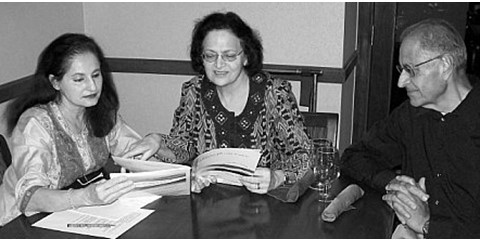
In the Pittsburgh Metro area, India’s Independence Day Celebration is synonymous with Saroj Bahl. Started in 1997 during the 50th Anniversary of India’s independence and held annually in August in the lobby of the Cathedral of Learning, this function is for all Indians in the tri-state area.
Born in 1943 in Nairobi, Kenya, Saroj is the child of immigrant parents from India. She grew up as a British subject in a traditional Indian family with weekend trips to the temple for Havan. She attended the Arya Samaj School. Nairobi was segregated with separate residential areas and schools for Whites, Blacks and Browns.
Saroj recalled, “For college education I went to Chandigarh in 1960. My first contact with India is so dear to me that even today a lump rises in my throat thinking about that day. I returned to Kenya in 1963, the year Kenya got independence from Britain. In Nairobi, I taught English, literature and history in Senior Cambridge School. In 1964 I got married to the newly minted doctor Mohinder Bahl who had just returned from Pune, India.â€
In Kenya, Saroj and Mohinder were blessed with three sons —Ashish, Monish and Sachin. They were set to have a great life in Nairobi.
But life is never static. External events change people’s lives forever. Exodus of Indians from Idi Amin’ Uganda in 1972 prompted Ashok, Saroj’s brother in Pittsburgh then, to tell Mohinder and Saroj to leave Kenya voluntarily before they were forced out. It was prophetic. The government of Kenya announced that all jobs would be Africanized.
In 1972 Saroj and Mohinder with three children landed in Pittsburgh. Mala, their fourth child, traveled free and was born in Pittsburgh. The Bahls never re-located and Pittsburgh became their home.
“In the early 70s, Pittsburgh had a small Indian community,” Saroj recalls. “There were no temples or organizations. We were like a small family meeting in homes around potluck meals. An Indian was just happy to see another Indian without regard to the region or religion. Soon there were talks about a Center and Temple for all Indians. Twelve couples including us made down payment for purchasing a church with attached land, at present location of the Hindu-Jain Temple in Monroeville.”
“I vividly remember,” She continued, “the first logo encompassed all religions including Hindus, Sikhs, Jains, Muslims and Christians.”
The influx of physicians, information technology and other jobs resulted in ballooning of the Indian Diaspora. The increased numbers of various groups led to their separation from the main body. This resulted in the formation of S.V.Temple, the Sikh Gurudwara and several other religious and regional organizations. The Jains and many Hindus joined hands and built the Hindu-Jain Temple.
Having grown up in the segregated Nairobi, and observing divisions among Indian immigrants in Pittsburgh, Saroj wanted a yet-to-be born platform where people would identify themselves as Indian first and only then have a label of a region or religion, showcasing our unity in diversity.” Saroj animatedly says, “Involving children in such an organization would give them a sense of pride in their roots.”
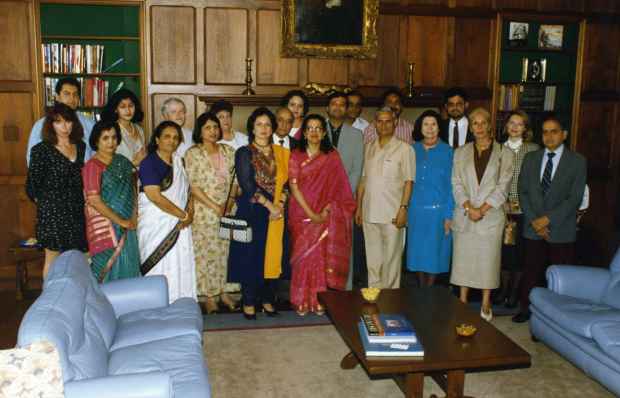
Around the same time, Chandrika Rajgopal, Deepak Wadhwani and Anu R Reddy, encouraged by E. Maxine Bruhns of Pitt’s Committee on Nationality Rooms, were working to create an Indian Nationality Room in the Cathedral of Learning. Their motivation was Indiaâ’s 4000-year unbroken tradition of pursuing excellence in learning.
Knowing Saroj’s commitment and work ethic at the Hindu-Jain Temple, she was invited to become part of the Indian Nationality Room committee. She joined enthusiastically.
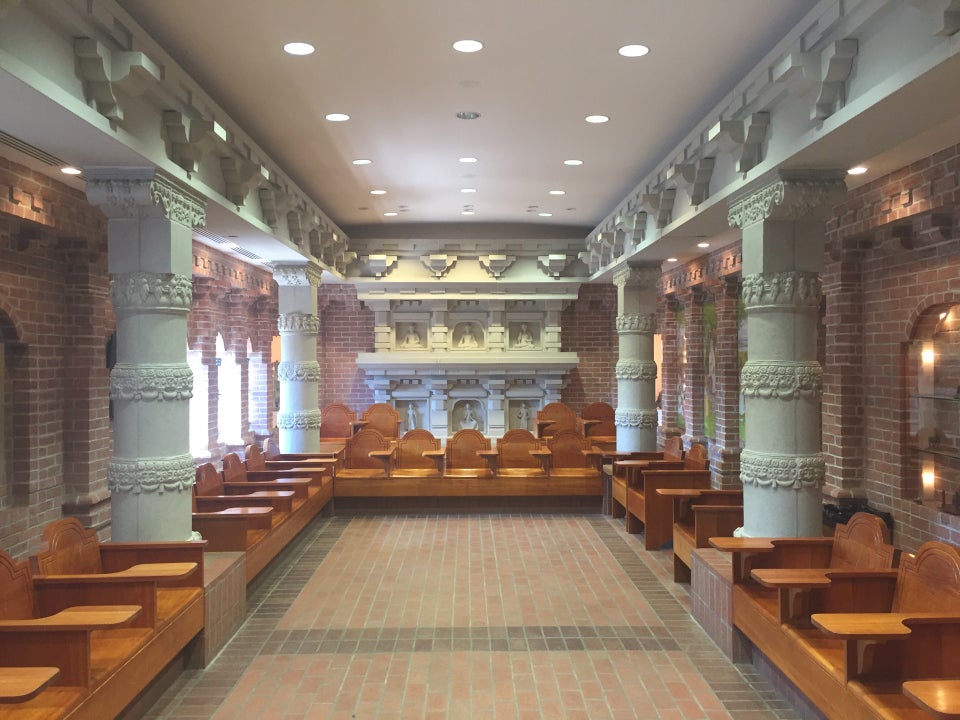
Through several fundraisers, generous support from the community and help from the dot-com boom, the committee raised $500,000 in record time. The Indian Nationality Room was dedicated on January 9, 2000. The project re-created inside the Cathedral of Learning a room depicting the ancient (5th century AD) learning center in Nalanda, established a scholarship program to send one deserving student to India every summer, and holds an annual essay competition.
Finally it was time for Saroj to start the annual Indian Independence Day Celebration to bring all Indians in Pittsburgh under one banner. Rashmi Ravindra, a long-time friend, active community member and supporter of Saroj from Day-1 says “Independence Day Celebration was totally Saroj’s idea.”
Saroj recalls, “It had a modest start with fewer than 100 people in attendance. Over the years, with participation from all Indian organizations and individuals, the annual event now attracts over 1000 people. In earlier years it was hard to find participants, but now the function has no shortage of excellent and enthusiastic performers. The dances and songs match the diverse motifs of independent India.”
“Are you happy with the format of the function?” I inquired.
Without any hesitation and with a chuckle she said, “I love the Mela (Carnival)-like atmosphere — diverse programs, folk music and dances, classical dances, speeches, some people watching the show, some eating, shopping and some doing their usual gup shup with intermittent loud laughter at the crack of old jokes!!”
The non-air-conditioned Cathedral in the sweltering August summer with less than ideal acoustics doesn’t seem to bother the participants or the audience. Saroj and her committee continue to look for other locations, but without success so far.
Constant improvements in the celebration led to an outdoor parade around the Cathedral of Learning. If rain is a good omen, it appropriately blessed the first parade in 2007, which consequently was held inside the Cathedral. Last year the parade on the streets surrounding the cathedral was a huge success with over 450 people marching to the beat of Nadaswaram and Tavil by visiting artists at the S V Temple.
I asked, “How do you manage to do all these?”
She laughed and said “I have full support from Mohinder and my children. But I just cannot complain in front of them that I am tired. Saroj also thanks all the Pittsburgh Indian organizations, her ten hard working committee members and the community who have brought the event to this level. All the accounts are handled by the University.
She acknowledged a few frustrations but, “they were nothing compared to the support I received from the community. I will do it all over again. I have enjoyed every minute of it and I have become a better person from this experience.”
Saroj is also actively involved with Silk Screen Film Festival, the Pittsburgh’s first India I-Day Celebrations in 1997. Bob O’Connor of Pittsburgh City Council was the main speaker.
Hindu-Jain Temple, and the National Association of Women Business Owners, which selected her as one of the Make The Connection Award Honoree in April 2009.
Her future dream is to see the Indian Independence Parade to take the dimensions of Irish or Greek parades held in downtown Pittsburgh with thousands in attendance. “I am in no rush. It will happen in its own time. I don’t know when, but that day will arrive for sure. Our youngsters are smart and well trained in organizational skills, business management, speaking abilities, and love for India.”
She continued: “For now, I will continue to give my best to the Independence Day Celebration. At the appropriate time, I will happily pass on the baton.” And she did it in the true Indian Vedantic style with detachment, handing over the baton in 2016 to Rashmi Ravindra and her team.
The small fire that Saroj lit has become a bright flame, and I am sure it will glow even brighter forever.   — ENDÂ
Obituary: Raj Gopal (1933 to March 16, 2009) — Entrepreneur & Pioneer for Hindu Places of Worship in the US
Posted by admin in Past issues, Venkat's and Others' Selected Earlier Articles on July 15, 2009
By Kollengode S Venkataraman (Published in July 2009)
Dr. Raj Gopal, who, in early 1970s envisioned a temple for all Hindus in Pittsburgh when the very idea of Hindu immigrants building a temple in the US with their own resources was considered a fantasy, died on March 16 in Coimbatore, India. He died suddenly while working on his project for helping tribal people near Ooty. He lived in Pittsburgh in the 1960s and 70s.
Gopal was born in Coimbatore to a middle class family. After his BE degree in PSG College of Engineering, he came to the US in 1955 and earned his PhD from RPI in electrical engineering in 1961. Returning to India and getting frustrated, he came back to join Westinghouse’s technology center in Churchill, where his work was filed for many patents.
In mid-1970s the euphoria among Indian immigrants for building an inclusive temple for all Hindus, and Sikhs and Jains evaporated soon after groundbreaking with disagreements over the scope of the project and the nuts & bolts of running the temple. A few mainstream Americans and several non-Hindu Indians, it is noteworthy, were active in this project.
Raj Gopal and several others coming from southern India broke away to build a temple of their own. This split culminated in building the Sri Venkateswara Temple. Gopal’s go-getting dynamism was instrumental in getting the bare temple with only the shrines dedicated for worship in record time in Fall 1976. He, with a group of South Indian volunteer-friends, worked with the Tirupati temple in India, raised funds under trying circumstances, worked with Penn Hills’ city hall convincing them for a permit for a Hindu temple, and on many other details.
Dr. Mahendra Mathur, who worked with Raj Gopal for a common temple for all Hindus, said, “Dr. Raj Gopal’s tireless efforts brought together the people and funds, and coordinated the construction of an authentic Hindu Temple in the Western Hemisphere for Venkateswara. His single minded commitment was truly exemplary.”
Cecilia and Udaya Shankar Rao who were involved with the temple since the beginning reminisced, “Still vivid in our memory is the day Raj brought in a bus fifteen shilpis who had flown to New York from India in summer 1976. We received them at the Churchill borough building. At that moment, the temple project became a reality for us.”
Soon after S.V.Temple’s dedication in Fall 1976, the very dynamism of Gopal’s leadership style, crucial for completing the temple in record time against many odds, became an issue between him and the South Indian team members who worked with him in building the temple.
This was partly because the nascent S.V.Temple was transitioning into a typical establishment with elections, committees, rules, not to speak of the compulsions of pressure groups and conflicting vested interests common in many Hindu temples in the US. Because of this and other inter-locking reasons, the relationship between Gopal and the governing members of the S.V.Temple irrevocably strained soon after the temple’s inauguration in 1976, and the strain sustained in later years.
Gopal was also an ambitious entrepreneur. He saw the potential for Indians in the IT industry a decade before its boom in the 1990s. However, his business ventures did not take off, partly because he was ahead of the time. In recent years, he went back to Coimbatore where he was active in the construction projects of Amrtanandamayi’s ashram and in guiding students at the PSG Institute of Management.
G. Manoharan, who worked with Raj Gopal in the early days of the temple, recalled: “Dr.Gopal was a legend of many dimensions. A brilliant student and a successful engineering manager. He conceived and spearheaded a project establishing a traditional Hindu Temple in the US. A visionary entrepreneur and humanitarian. Loving husband and father of three admirable daughters. A role model.”
Sarita and Smitha, two of Gopal’s three daughters and their mother Rajshri were in Coimbatore for his cremation rites.
Raj Gopal’s associates and acquaintances in Pittsburgh earnestly acknowledge his vigor in getting the S.V.Temple built in record time. On this point, even his detractors agree, as it was evident in what was said in a memorial gathering for Raj Gopal at the S.V. Temple in May.
That the temple Gopal was instrumental in building is now a pilgrimage place for Hindus in the US is an acknowledgment for his vision and his single-minded dedication for the project. — END
Getting a Call from the FBI —
Posted by admin in Past issues, Venkat's and Others' Selected Earlier Articles on July 15, 2009
Participating in the FBI Citizens Academy
By Kollengode S Venkataraman (Published in July 2009)
Last January, there was a message in my answering machine from Pittsburgh’s FBI (Federal Bureau of Investigations) office asking me to call them back in connection with one of their outreach programs. I wondered why they selected me for the program. Having traveled to many counties on work, did I unknowingly violate any of the National Security guidelines? Is the “Outreach Program†a euphemism to lessen the impact?
I promptly called their office the next day, hoping to soon be out of their radar screen. Much to my surprise, they told me they would like to nominate me for the FBI Citizens Academy Program. If selected, I need to commit myself for an 8-week course held once a week between 5:30 pm and 9:00 pm. They asked, “Are you interested?â€
My nervousness vanished. But I was curious. Who are the other nominees? I wanted to be sure what I was getting into. They told me the other attendees are citizens from a variety of backgrounds all from around the Pittsburgh area. After checking with my supervisor at work, I accepted their nomination.
On the first day, they set the stage: Law enforcement is society’s response to crime and violence by people against fellow citizens. Traditionally, the thrust in law enforcement has been prosecuting crimes after they are committed. In the wake of the September 11, 2001, questions were raised on this approach by elected officials, citizens groups, and by the law enforcement agencies themselves.
Prosecuting crimes is still important. But preventing crimes was seen as more desirable and cost-effective than prosecuting crimes. After all, law enforcement agencies are there to protect law-abiding citizens.
Further, till 9-11, law enforcement agencies at the local, county, state and federal levels were silos, often having very little communication with each other. Since the resources of law enforcement agencies are finite, there were advantages in breaking down walls between them and using each other’s resources to their collective advantage.
The FBI took this idea one step further, deciding to build bridges by using citizens at large as partners in preventing crimes. Towards this, the FBI holds a structured 8 to 10-week course titled “FBI Citizens Academy†in key locations every alternate year. FBI selects the participants from a WIDE cross section of citizenry – teachers, postal employees, community organizers, lawyers, company executives, entrepreneurs, chaplains, and sometimes even celebrities. My class included Franco Harris of Immaculate Reception fame, giving myself the lifetime bragging rights to claim Franco Harris as my classmate!!! 😉
On the first day, nearly forty well accomplished but regular-looking (except Harris) citizens (both black and white) were at the FBI office in the South Side. I was the only conspicuously looking non-mainstream guy.
Naively, I thought the emphasis would be on terrorism, particularly external ones – al Qaeda and the like. But external terrorism was only a small part in one session. They also discussed internal terrorists, both right-wing (Unabomber, Oklahoma City) and left wing.
Each week, they had two or three sessions. The topics covered the whole gamut: drug trafficking and money laundering; public corruption by judges and elected officials such as congressmen, state representatives, city councilmen; organized crime; violence against minors and child pornography; corruption inside law enforcement agencies themselves including the FBI; crimes related to intellectual property; and many others.
In the training, they were the first ones to admit that they too, sometimes, make mistakes and their own personnel commit crimes. The speakers — all veteran FBI officials — highlighted some of their high-profile cases and how they prosecuted them. The program’s other highlights:
1. Identifying and gathering blood and other DNA samples, fibers, foot prints in crime scenes – mostly painstaking grunt work that is nothing like what you see while watching an episode of CSI.
2. Polygraph testing and psychological profiling.
3. Managing a very real-life simulated terrorist threat in downtown Pittsburgh that involved poison gas, evacuation, hundreds of deaths; coordination with multiple agencies, making split-second decisions and having to live with the consequences of those decisions… …
4. Police chase that simulates high-speed driving in a real police car, including wide/sharp turns, burning tires, and screeching halts.
5. And finally, firearm training with live ammunition.
If you get a call from the FBI in future asking you if you would like to be nominated for the Citizens Academy, say “yes†rightaway. You will interact with a group of people coming from different backgrounds. Given the insular lifestyles in the US, it is not easy to meet people from such a wide range of backgrounds. More difficult still is to get a flavor of the challenges law enforcing agencies face, the constraints under which they operate, and how they operate. — End
Thank You, Governor Jindal!
Posted by admin in Past issues, Venkat's and Others' Selected Earlier Articles on April 15, 2009
By Kollengode S Venkataraman — Published in April 2009
Given the partisanship among the members of Congress, talking heads and punditocrats, we need to take it seriously when Democrats and Republicans agree on anything. That is what happened on February 24 when the talking heads started billowing their opinions on TV moments after Louisiana’s GOP Governor Bobby Jindal ended his response to President Obama’s address to the joint session of Congress. These were the captions to news stories the next morning:
New York Times: Governor Jindal, Rising G.O.P. Star, Plummets After Speech
Washington Post:Republicans, Democrats Criticize Jindal’s speech
Washington Post’s’ Media Notes: How bad was Jindal?
Los Angeles Times: GOP not pleased with Jindal’s speech
AP’s Beth Fouhy: Republicans, Democrats criticize Louisiana Gov. Bobby Jindal’s speech on style and substance
Chris Mathew, a liberal, on MSNBC muttered “Oh God!†as Jindal strode into his microphone from his ornate governor’s mansion in Baton Rouge. A blogger on Wonkette.com gave an Indian twist in jest: “Oh Ganesha!â€
But among Jindal’s detractors were David Brooks of New York Times, Brit Hume of Fox, and Charles Krauthammer of Washington Post, all Conservatives. Only Rush Limbaugh and Sean Hannity were defending Gov. Jindal.
As an Indian-American, I am not at all unhappy at the whacking Gov. Jindal received. He is a Brown University graduate (biology major), and a Rhodes Scholar at Oxford. He got admission into Harvard med school, which he did not pursue. With this background, as governor, he signed a bill that allows teaching of the Biblical story of creation (according to which the universe is only 6000 years old) in science classes in schools in Louisiana.
In his GOP response to Obama’s address Gov. Jindal said this on the federal government spending the $140 million for volcano monitoring: “Instead of monitoring volcanoes, what Congress should be monitoring is the eruption of spending in Washington, D.C.†Commentators berated Jindal right away on how he would have responded if the money went for hurricane monitoring systems along the Louisiana Coast.
For a man of his upbringing and high quality education, Jindal is appallingly ignorant in his understanding of this vast nation’s metropolitan areas precariously tied to the vagaries of geography — earthquakes, volcanoes, tsunamis, snow storms… …
After his state using all the resources of FEMA including the US military and the billions of federal money for Katrina relief, Jindal said this: “Today in Washington, some are promising that government will rescue us from the economic storms raging all around us. Those of us who lived through Hurricane Katrina, we have our doubts…. …
“There’s a lesson in this experience: The strength of America is not found in our government. It is found in the compassionate hearts and the enterprising spirit of our citizens.†And then this doublespeak: “We’re grateful for the support we’ve received from across the nation for our ongoing recovery efforts. This spirit got Louisiana through the hurricanes, and this spirit will get our nation through the storms we face today.â€
Gov. Jindal believes that society can manage the rescue efforts for a Katrina-type hurricane with human and material resources entirely from volunteer efforts of citizenry alone. Does Jindal really believe New Orleans could have managed the social and material wreckage of Katrina without tax-payer funded FEMA coming to the rescue? If he does, he needs to grow up quite a bit before dreaming himself standing at the portals of the White House as a future occupant.
I, for one, am glad that not only he was berated by both the liberals and conservatives, but also ridiculed in late-night comedy shows.
One hopes Jindal does not represent the mindset of the thousands of children of Indian immigrants born and raised in the US in cozy middle-class Indian homes. If he does, that should scare all of us. — END
Mercury Poisoning in Making Gold Kavachams
Posted by admin in Past issues, Venkat's and Others' Selected Earlier Articles on April 15, 2009
By Kollengode S Venkataraman (Published in April 2009)
Many religious places of worship, including Hindu temples, consider it special to adorn their icons/deities and decorate their floats with coverings made of precious metals and gemstones, and use them on special occasions. The metal covering is called Kavacham in Sanskrit, meaning “sheath.â€
Hindu Temples with modest resources have relatively less expensive silver kavachams (silver price is only small fraction of gold’s). However, for temples with better resources, the preference is the gold kavacham not only on their deities, but also for floats and even dwaja-sthambham (traditional flagstaff) in front of the temple.
Resourceful temples have used solid gold sheets. The well-known example is Amritsar’s Golden Temple. A much older sheathing with solid gold plates is at the Chidambaram temple, done during the Chola’s time a millennia ago. Traditional goldsmiths in India have been preserving for centuries the intricate artwork on metal carving/engraving.
Temples want inexpensive gold coverings: With the gold price hovering around $950/oz, making kavachams with solid gold sheets is prohibitively expensive even for rich temples. So, simulated gold kavachams have become the staple. In making these “gold†kavacham, very thin foils of gold are worked onto the surface of less expensive copper kavacham.
Traditional Gold-Plating Techniques: Making these “gold†kavacham uses mercury at high temperatures for working gold foils onto the copper substrate through amalgamation. Handling mercury at high temperatures gives out mercury vapors, a deadly poison with high toxicity when ingested into the body. See the health deadly effects of mercury poisoning at the end. One four-step technique of making “gold†kavacham follows:
1. Making a rigid kavacham using 1 to 2-mm thick copper plate. Copper is malleable for artisans to engrave intricate details such as ornaments, facial expressions, and sartorial details on the kavachams. It is also less expensive. Traditional artisans do an outstanding job in engraving most intricate details on metal kavachams.
The next is to giving a gold covering on the copper kavacham. Modern gold electroplating using cyanide baths, a known technology, is one option. This requires strict safety and industrial hygiene practices because of the use of deadly cyanides. But gold electroplating of the kavacham is difficult because of their unwieldy sizes and shapes. The other difficulty is the poor quality of the gold plating on uneven surfaces with intricate details.
So, temples contract the work to traditional metal smiths in India, who have preserved a centuries-old 3-step technique developed in the pre-industrial revolution era that uses mercury and high temperatures.
2. They heat the copper kavacham pieces to around 200 deg C, and smear the copper surface with the liquid metallic mercury. At these temperatures mercury forms an amalgam with the copper surface. But it also releases deadly mercury vapors in the vicinity of the furnace.
3. Separately, they make foils of pure gold, which is quite malleable. The foils are only tens of microns thick (1 micron = 1/1000 millimeter).
4. They then re-heat the amalgamated copper kavacham pieces obtained in step 2, and painstakingly work the thin gold foils on the heated mercury-rich copper surface. The gold foil forms an amalgam with mercury on the copper substrate and adheres to the copper base. During this high-temperature process, the mercury already on the surface again vaporizes.
Workers exposed to high amounts of mercury vapors: The boiling point of mercury is relatively low, only 356 deg C. Therefore, at the working temperatures around 200 deg C , mercury vaporizes into air.
The concentration of mercury is the highest in the immediate vicinity of the heating furnace where the metal smiths work. This cottage industry is totally unregulated in India and it is inevitable that workers ingest the mercury vapors through breathing, mouth and also through their skin.
In all likelihood, even in the finished kavacham pieces, the mercury concentration would be high on the surfaces of the kavacham.
Mercury poisoning is deadly: Mercury, once ingested, is not readily flushed out of the body. The website www.noamalgam.com lists the deadly incurable and progressively degenerative diseases caused by mercury poisoning. Mercury poisoning leads to premature death of people exposed to mercury vapors. That is the reason why it is banned in tooth filling and in thermometers.
The safe exposure limits for mercury adapted by WHO is 0.46 microgram/day/kg of body weight. (Note: 1 microgram is 0.000001 of a gram). Obviously working near the furnace will expose people to high levels of mercury, likely to be several hundreds, possibly even thousands of times above the safe working limit.
The reason for the silence: Traditional metal smiths have preserved the technique for generations, keeping it within their families/clan. Since the technique is preserved within their families, the incomes also stay within their families. Since they are also the sole beneficiaries of this lucrative business, they do not complain.
The temples also keep quite because it gives them inexpensive “gold†kavachams, far less expensive than solid gold coverings. And the ordinary temple-goers rarely know the details of the kavacham-making techniques to understand the associated health risks.
Indian-Americans are better educated with higher degrees in health care, chemistry and engineering. Hence the purpose of this write-up is to raise the awareness of the serious health risks for workers making these gold kavachams.
Once people recognize the dangers of mercury poisoning, one hopes it would lead to some soul-searching among the decision makers on whether we need these mercury-laced “gold†kavachams at all. After all, will we ever let our children go anywhere near the kavacham making furnace?
Partial list of diseases caused by mercury poisoning:
Addison’s disease, gastritis, allergies, hypogonadism, Alzheimer’s’ disease, hypothyroidism, Amylotrophic lateral sclerosis, infertility, ankylosing spondylitis, insomnia, anorexia nervosa, irritable bowel syndrome, anxiety, juvenile arthritis.
Asthma, learning disabilities, attention deficit hyperactivity disorder, lupus, erythromatosus, autoimmune diseases, manic depression, bipolar disorder, multiple chemical sensitivities, borderline personality disorder, multiple sclerosis, bulimia, myasthenia gravis, candidacies, obsessive-compulsive disorder.
Chronic fatigue, panic attacks, colitis, Parkinson’s disease, Crohn’s disease, pervasive developmental disorder, depression, psychosis, endocrine disorders, schizophrenia, fibromyalgia, sciatica, food allergies. — END
From the Inaugural Address of Obama
Posted by admin in Past issues, Venkat's and Others' Selected Earlier Articles on April 15, 2009
By Kollengode S Venkataraman (Published in April 2009)
America’s ascension in economic, military, and political strength comes out of its commitment to research in basic and applied sciences and using the findings to make money through profitable technology, not worrying too much about whether the technologies are useful or even ethical.
In this endeavor, thousands of scientists and researchers have spent, and continue to spend, the most productive years of their careers to continuously improve our understandings of Nature’s mysteries. On top of this heap of Seekers of Truth are those who receive global recognitions for their work. Needless to say, without the big heap, there is no peak.
That is why researchers from the American soil (both as native-born and as immigrants) have dominated Nobel prizes in chemistry, physics, medicine, and economics throughout the 20th century.
So, there was no need for a US president to declare in his inaugural speech the nation’s commitment to science. Yet, that is what President Obama did: “We will restore science to its rightful place…â€
He was alluding that in the last twenty-five years dogma borne out of deeply held religious beliefs took precedence over science in national debates on applying newer insights in science and discoveries in technology to modern life.
Since science in its essence is value-neutral, it is necessary for people to raise questions on how we apply science to make a profit, or worse still, to cause pain and suffering on helpless people as in wars – by using sophisticated guided missiles, land mines, and chemical warfare, and damaging the environment with chemical defoliants.
It is natural for people – officials of organized religions, including religious believers, and even unaffiliated citizens — to be uncomfortable when new findings in science and technologies challenge our deeply held beliefs. That is precisely what scientific discoveries are supposed to do: Challenge our beliefs on the basis of improved understanding of Nature.
But when such discomforts get organized through selective opposition on the basis of religious/political dogma, it carries less moral weight.
As a matter of fact, throughout history in the Western world,
almost every new scientific discovery was opposed by its religious orthodoxy of that era. Galileo’s assertion in 16th century that earth revolved around sun (originally suggested by Copernicus) was so disturbing to the Vatican’s orthodoxy that he was excommunicated. Only in 20th century, the Vatican decided to correct itself.
Similarly, the church opposed initially anesthesia, blood transfusion, organ transplants, in vitro fertilization, and now embryonic stem cell research, supposedly on ethical grounds, but actually dosed heavily on dogma. The church also denies the findings of evolutionary biology.
As expected, President Obama in early March issued an executive order ending the President George W. Bush’s ban on embryonic stem cell research. Embryonic stem cell research has the potential for finding cures for several chronic and denerative diseases that currently need expensive life-long medications and treatment or no treatment at all.
Often, losing the argument, the religious orthodoxy embraced science. Where it did not embrace, its opposition eventually became irrelevant, as in the case of use of contraceptives. I wonder why religious orthodoxies has no stand on the use of Viagra by senile men.
Given this atmosphere, it was refreshing to hear President Obama declare, “We will restore science to its rightful place… …â€
The second phrase that stood out was when President Obama
talked about faith. This is what he said: “We are a nation of Christians and Muslims, Jews and Hindus and non-believers……â€
President Obama included nonbelievers among the people of faith, who believe in an all-powerful, all-knowing, merciful God who occasionally unleashes his wrath on man. As an agnostic, but practicing Hindu, I was fascinated not by Obama including Hindus, but by Obama including nonbelievers.
In the abstract, one can argue that a dogmatic nonbelief itself is a belief. For now, I set aside this verbal gymnastics.
In the last twenty-five years in the US, an impression is created subliminally in political and social discourse that nonbelievers, though not evil, are amoral, not guided by any morality. But as we have seen repeatedly, evil and the absence of moral and ethical compass are equal-opportunity human traits. Throughout history, more violence and evil were let loose by believers among themselves and towards others as well.
And often, leaders of organized faiths in all religions have displayed total lack of ethics and morality that they preach for others. As a matter of empirical observation, many nonbelievers and even atheists lead very ethical lives. And many theists live diabolically given to debauchery.
For many in the West and Indians as well, it is incomprehensible that you can have religions without the need for God as the fulcrum. Two such religions are very old, at least five centuries years before Christ. Both these faiths have very sophisticated works on its doctrines, ethics, and even dogma. And both are born in India.
One is Buddhism, founded by Gautama Siddhartha in the fifth century BC, after his decades-long search for answers to human misery. Gautama Buddha’s teachings are so sophisticated that he completely bypasses the need for God, neither denying nor affirming the idea of God. Buddhism’s early works on the 8-way path does not invoke God, does not plead for God’s mercy, and does not supplicate God for not unleashing his wrath.
The Buddha’s central message is: Life is difficult, transient, and full of pain. Sarvam duhkham sarvam anityam. But the Buddha was not a pessimist. Far from it. He offeres a way out giving a general path out of misery that one needs to travel by oneself, something he traversed himself.
Jainism, consolidated in the 6th century BC by Vardhaman Mahaveera, the 24th Tirthankara* in the Jain tradition, is atheistic in its essence. Its idea in karma is simply this: “Hey Guy, You find yourself in the ditch mostly because of your own actions. Now you need to get out of the ditch. Many others have done it. You can do it too. While others can be your inspiration, only you can get yourself out. The effort has to be yours.â€
Buddhism, Jainism, and Hinduism all believe in Karma. Buddhism and Jainism, however, without the need for invoking and believing in the idea of God, show people a way out of misery with their own self-effort.
Even within the Hindu fold, non-belief is never condemned. As a matter of fact, non-belief is a well-accepted idea within the Hindu fold. Sankhya, one of the six schools (Shad-darshanas, or Six Views) in the Hindu tradition, for example, is atheistic.
If you associate people’s morality and with their faith in God, how do you explain this?: The atheistic Jainism is totally committed to nonviolence not only toward other human beings, but also towards all other living beings. Even Mohandas Karamchand Gandhi was influenced by his Gujarati upbringing, which is a melding of Jainism and Hinduism.
And in many parts of India, even today, Jain charities are well known in hospice care, and running hospitals and educational institutions.
Ido not know how many US presidents have come out so openly
embracing nonbelievers. But in an environment where religious and political establishments were demonizing nonbelievers in their rhetoric, it was refreshing to hear President Obama’s nuanced approach to belief.
*Tirthankara in Sanskrit means “He who has crossed over the ocean of samsara or Lifeâ€, and Vardhamana Mahavira is the 24th Tirthankara. — END
What goes with Masala Bhindi? Burgundy?
Posted by admin in October 2009 on March 13, 2009
To my pleasant surprise, Mike and Deb, our wine gurus, were practical, friendly and helpful. Emphasizingthat there is nothing objective in matching food with wines, they offered a few broad general ideas:
l Shiraz with spicy eggplant,
l Zinfandel with tandoori chicken, and so on.Obviously, Mike and Deb know about desi food too
California Chardonnay with prawn curry,
l German Riesling Spatlese for samosas,
l Shiraz with spicy eggplant,
l Zinfandel with tandoori chicken, and so on.Obviously, Mike and Deb know about desi food too
Â
In addition, their store is chock full of gadgets you probably didn’t even know you need to complement your wine collection.
Â
, in the Strip District.
Â
Â
Â
So the next time you feel the need to polish up your wine information while having fun sampling wines, try one of Deb and Mike’s wine appreciation classes. You will enjoy the experience.
But remember this: When you have good company and engage in good conversations with repartees and banter, the verbiage around the wine is, well, ephemeral, relevant only during the first two sips. And once you’re slightly inebriated, the wine’s pedigree may not matter at all.

